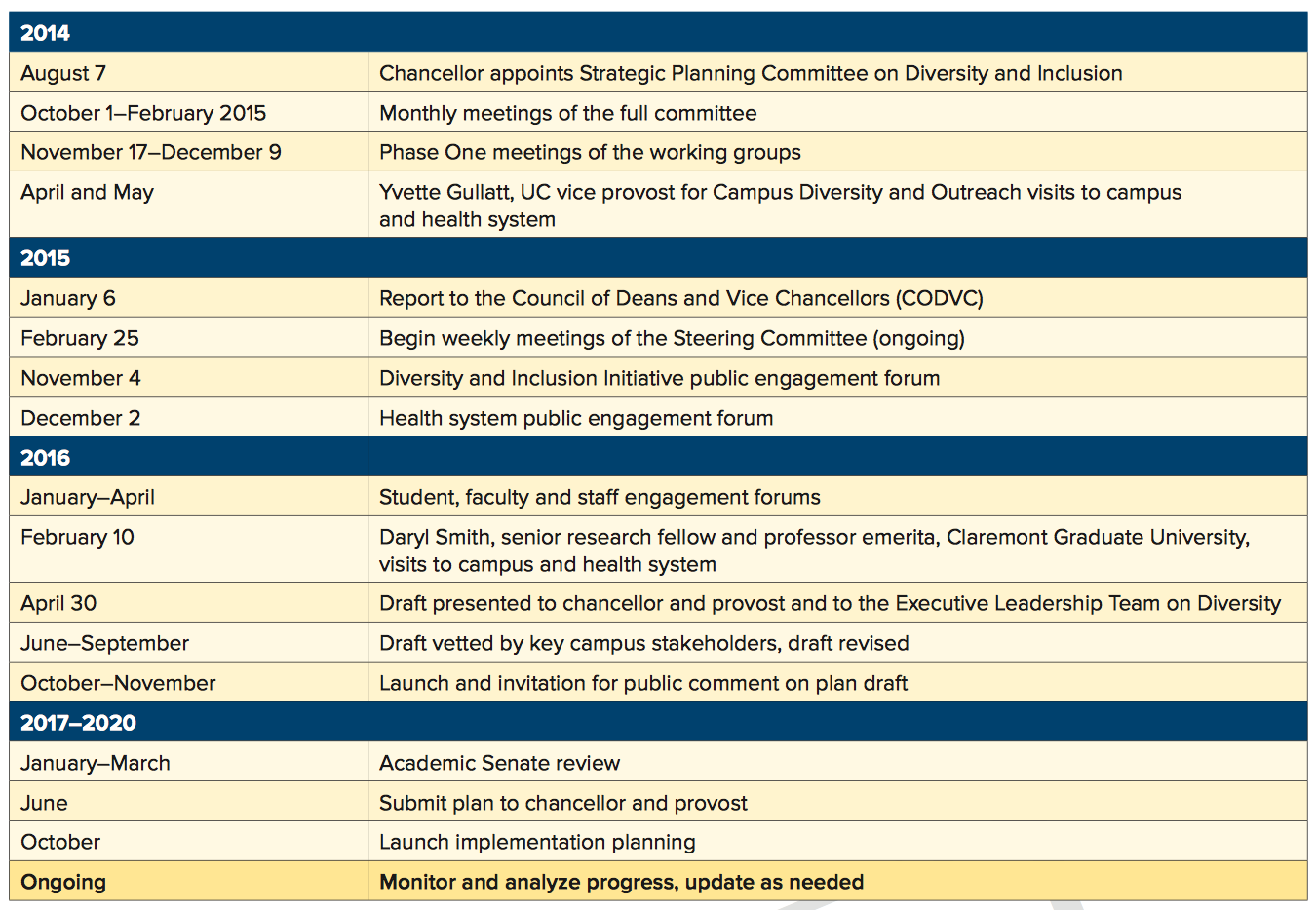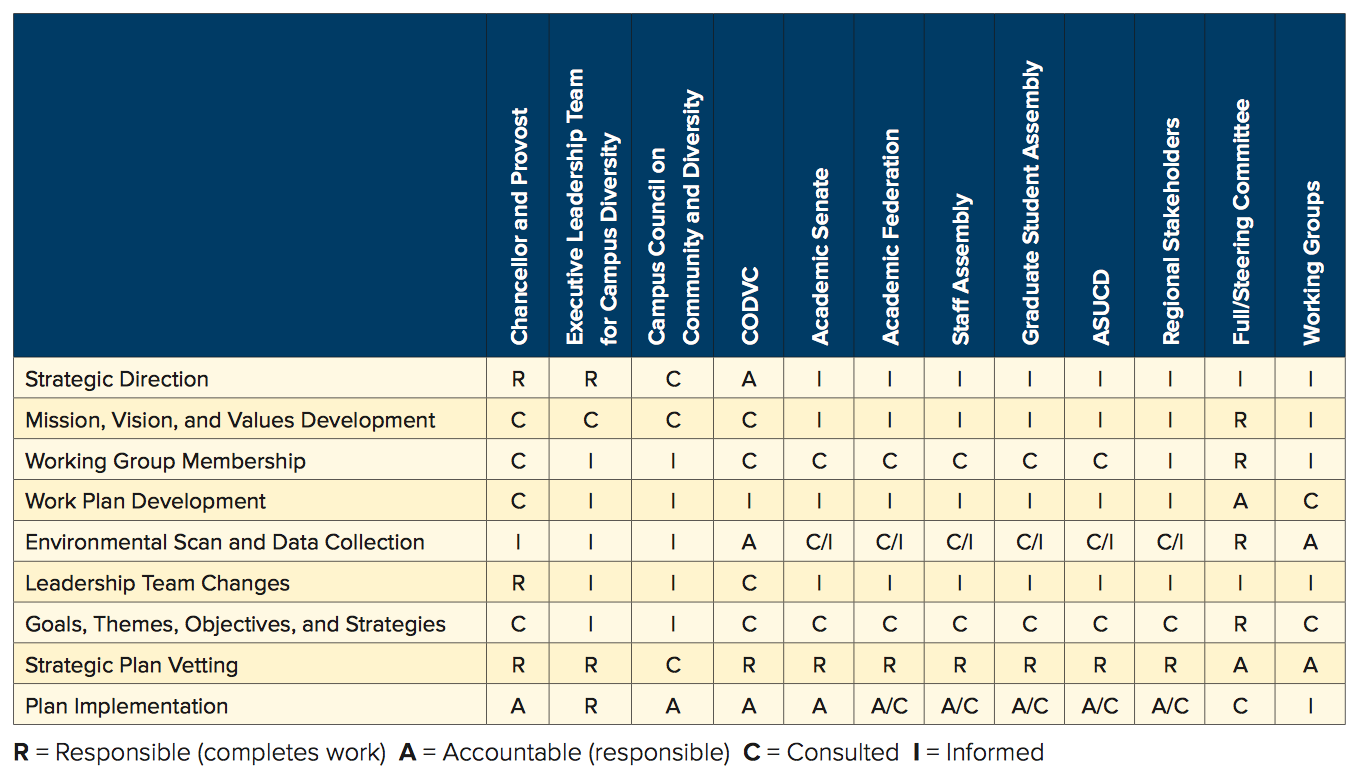The Strategic Planning Process
UC Davis Diversity and Inclusion Strategic Vision
In August 2014, Chancellor Linda Katehi charged a committee to begin the planning process. The original committee began to meet in October 2014 and spent its first year setting the foundation for the planning process. They defined stakeholders and performed background research. The scope of the review included past initiatives addressing diversity and inclusion; active programs sponsored by campus units, divisions, schools, and colleges; best practices at peer institutions; and advice from leaders within and beyond a university setting.
In October 2015, a reorganized Diversity and Inclusion Steering Committee defined themes and goals to guide further discussion and delegated specific constituent discussions to six working groups:
- Regional stakeholders
- Undergraduates (represented by the Student Committee on Campus Climate)
- Graduate and professional students and postdoctoral scholars
- Academic Senate
- Academic Federation
- Staff
These working groups were asked to:
- Identify challenges and opportunities for improvement
- Propose approaches to address these challenges and opportunities
- Develop key short- and long-term strategies
Additionally, three advisory groups were created to consider the development of a diverse pipeline, data management and analysis, and communications. The steering committee agreed that a mechanism for ongoing accountability and institutionalization of recommendations would also be built into the strategic plan.
An analysis of key findings from the public engagement forums that took place between November, 2015 and April, 2016, along with findings from previous campus reports (2007–2014), and from more recent reports, such as the Ombuds 2014–2015 report, were provided to the steering committee and working groups throughout the planning period. The campus mission statement, the chancellor’s vision statement, “A Vision of Excellence,” the Principles of Community, and the UC Diversity Statement were four central documents that informed the development of this Strategic Vision for Diversity and Inclusion. The steering committee also took into consideration the campus’ 2020 Initiative: “an ambitious plan to build on the institution’s excellence, create a more diverse community of scholars and achieve financial stability … [and put] the university on a path toward adding up to 5,000 new [undergraduate] students by 2020, along with corresponding increases in graduate students, faculty, staff and facilities.” Informing the 2020 Initiative is the University of the 21st Century strategic framework, presented to the UC Board of Regents in spring 2016. This framework focuses on new and progressive learning paradigms that place the student at the core of the institution; includes centers of innovation in education, research, scholarship and administration; offers a strong presence and visibility in Sacramento; recommends an investment in addressing deferred maintenance and new construction to support expansion in enrollment; emphasizes improvement in delivery and access for health services; and calls for a plan for financial sustainability. The California Master Plan for Education, in opening higher education to all deserving students regardless of economic circumstance or any other factor, must play a foundational role in any vision for diversity and inclusion at UC Davis.
In the 2015 convocation, Chancellor Linda Katehi reaffirmed the goal to help students graduate in four years and increase four-year graduation rates from 55 percent to 75 percent by focusing on student services and support. A number of other systemwide and campus initiatives and reports complemented the Diversity and Inclusion Steering Committee’s work, including the health system’s process for updating its diversity framework and strategy within the larger strategic plan for the health system. Chancellor Linda Katehi appointed several other committees to address access to success and workplace climate: The Human Equity Subcommittee of the University of the 21st Century Committee, the UC Davis Equity Task Force, and the Task Force on Workplace Climate, all of which have informed the recommendations contained in this report. At key milestones in the planning process, the chairs engaged in intensive consultation with key stakeholders and stakeholder groups (see Figure 3) and will continue to work with those groups to ensure full accountability and institutionalization of recommendations in the plan.



Read Guidelines for Implementation Planning
Start reading the Goals and Objectives for:
Pipeline, Recruitment, and Retention
Climate
Research, Teaching, Public Service, and Training
Institutional Commitment
You can download a PDF version of the plan here.
Engagement Forum Findings
November 4 Forum Key Findings (PDF)
December 2 Forum Key Findings (PDF)
